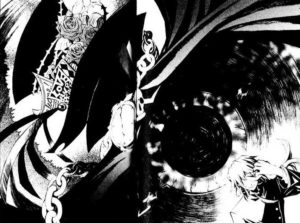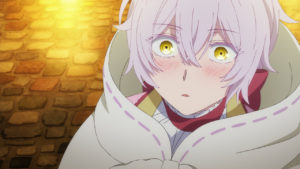My Favorite Literary Allusions in Anime and Manga
It’s actually quite common for literary allusions (or references) to show up in manga, light novels, and anime! The following is a list of references in no particular order of importance (most of the ones listed are Western literature references because those are the ones I’m able to pick up on with my English Major senses tingling).

 How a Realist Hero Rebuilt the Kingdom is a manga and light novel series as well as an anime. Kazuya Souma, the main character, is summoned to another world through a hero-summoning-ritual. He is then placed in the position of king and forced to govern without any real prior experience. In one of the episodes, he quotes Niccolò Machiavelli’s The Prince to provide something of an explanation for his actions during said episode (to the right is the image of the The Prince used in one of the earlier episodes of the anime). Machiavelli’s writing claims that it is better for a ruler to be on the crueler side and feared by the people as opposed to being too kind. Kazuya Souma is a very intelligent character and uses a lot of modern-day science and classic literature to help him make decisions.
How a Realist Hero Rebuilt the Kingdom is a manga and light novel series as well as an anime. Kazuya Souma, the main character, is summoned to another world through a hero-summoning-ritual. He is then placed in the position of king and forced to govern without any real prior experience. In one of the episodes, he quotes Niccolò Machiavelli’s The Prince to provide something of an explanation for his actions during said episode (to the right is the image of the The Prince used in one of the earlier episodes of the anime). Machiavelli’s writing claims that it is better for a ruler to be on the crueler side and feared by the people as opposed to being too kind. Kazuya Souma is a very intelligent character and uses a lot of modern-day science and classic literature to help him make decisions.


Black Butler is a manga following a 13 year old boy (pictured left) that has sold himself to a demon (pictured right) in a very Faustian way. But Faust is not the reference I’m going to talk about here! The anime and manga both feature a murder mystery story-arc (which is possible to watch without watching anything else in the anime due to it being a two part Original Video Animation) that references the Sherlock Holmes stories in a very obvious way (outside of Sir Arthur Conan Doyle being an actual character in the series). The murder mystery is also reminiscent of “The Adventure of the Speckled Band” with the character Snake (spoiler alert) actually being the cause of the murder via (wait for it) one of his snakes. This is similar to the “speckled band” in the short story turning out to be a snake. Another interesting point is that Sebastian Michaelis comes back in the story arc disguised as “Jeremy Rathbone” (pictured below) which is a fusion of not only Jeremy Brett but also Basil Rathbone (two actors that have very famous depictions of the character Sherlock Holmes).

As a side note, Sherlock Holmes references in anime are relatively common and often my favorite but there are many different depictions of “reimagined” Sherlock Holmes stories. One such being Moriarty the Patriot which, instead of following Sherlock, follows his infamous rival Professor James Moriarty (or, in this case, William James Moriarty and his two brothers that also have the name “James Moriarty”). In the picture below, Sherlock is on the left and Moriarty is on the right.

Shakespeare references are also frequent as many of the school plays featured in anime during their school festival arcs have something to do with Shakespeare. This is especially true for the shoujo romance stories! Everyone loves a good Romeo and Juliet rendition when trying to get the two love interests to kiss. But another noteworthy reimagining is Requiem of the Rose King. An anime and manga series which retells the story of Shakespeare’s major historical drama: King Richard III as well as taking from Henry VI Part 3.

Blue Exorcist features a character by the name of Mephisto Pheles (pictured on the manga volume cover below). This is play on the name Mephistopheles (which has a multitude of spellings, by the way) the demon in Faust by Johann Wolfgang von Goethe. Mephisto in the series also uses the name Johann Faust V as his “human” name, referencing either the author of the play or the real life individual (Johann Georg Faust) that is believed to be the basis for the play’s “Faust.” Mephisto is a very tricky character that does justice to his counterpart. Aside from the obvious counting in German that he does before casting some sort of spell (Eins, Zwei, Drei), he also wears mostly white. This is incredibly unusual for a demon, especially the demon who is a principal of an exorcist school where the uniform is entirely black! Mephisto makes a habit of giving unclear answers to questions and frequently avoiding the root of the problem. He is exactly the type of character that no one else in the story can read. His tricky answers are also reminiscent of Mephistopheles in the play, as the demon typically provides very entertaining responses of “why does it matter to you anyway” when answering Faust’s questions of heaven, hell, or the afterlife.


Some more honorable mentions of content greatly inspired by classic literature include: the Fate/ series, Persona, and Bungo Stray Dogs (as well as Bungo and Alchemist: Gears of Judgment). The Fate/ series makes a habit of taking huge literary (or historical) figures and reimagining them as characters. Some popular ones include: King Arthur, Gilgamesh (pictured below), Alexander the Great, and Leonardo DiVinci. The Persona series does a very similar thing with the personas. In Persona 5, the protagonist’s (“Joker” pictured left) persona is Arsene which is an obvious take on Arsène Lupin, the gentleman thief. Very fitting considering that the game follows a group of teenagers calling themselves “The Phantom Thieves” (I’ll also add that in the stories of Arsène Lupin, Herlock Sholmes is his arch-nemesis and the detective trying to catch him… gee, I wonder who that might be referencing?). 
 Bungo Stray Dogs is an entire series revolving around characters that are based off of real-life authors where their super-power-abilities are named after titles of the author’s works or a reference to the work. For example, my favorite character: Osamu Dazai is loosely based off of the real-life Japanese author Osamu Dazai with his special ability named “No Longer Human.” This is a direct title usage of real-life Dazai’s No Longer Human. Something that might be a bit more relatable for a Western audience is F. Scott Fitzgerald’s character: Francis Scott Key Fitzgerald (pictured below). Anime/manga Fitzgerald’s ability is “The Great Fitzgerald”, an obvious play on The Great Gatsby, where the more money Fitzgerald spends, the greater his physical strength becomes. Bungo Stray Dogs, however, is not the only anime to do this with traditional authors (especially Japanese-literary figures); Bungo and Alchemist: Gears of Judgment does the same thing. However, while Bungo Stray Dogs likes to play with the relationship dynamics between the real-life-authors (oftentimes reversing them), Bungo and Alchemist does not. For example, Ryūnosuke Akutagawa was one of the authors real life Osamu Dazai held in high esteem. In Bungo Stray Dogs, Akutagawa is the one that pines after Dazai whereas in Bungo and Alchemist, the situation is the same as real-life and Dazai is still following after Akutagawa.
Bungo Stray Dogs is an entire series revolving around characters that are based off of real-life authors where their super-power-abilities are named after titles of the author’s works or a reference to the work. For example, my favorite character: Osamu Dazai is loosely based off of the real-life Japanese author Osamu Dazai with his special ability named “No Longer Human.” This is a direct title usage of real-life Dazai’s No Longer Human. Something that might be a bit more relatable for a Western audience is F. Scott Fitzgerald’s character: Francis Scott Key Fitzgerald (pictured below). Anime/manga Fitzgerald’s ability is “The Great Fitzgerald”, an obvious play on The Great Gatsby, where the more money Fitzgerald spends, the greater his physical strength becomes. Bungo Stray Dogs, however, is not the only anime to do this with traditional authors (especially Japanese-literary figures); Bungo and Alchemist: Gears of Judgment does the same thing. However, while Bungo Stray Dogs likes to play with the relationship dynamics between the real-life-authors (oftentimes reversing them), Bungo and Alchemist does not. For example, Ryūnosuke Akutagawa was one of the authors real life Osamu Dazai held in high esteem. In Bungo Stray Dogs, Akutagawa is the one that pines after Dazai whereas in Bungo and Alchemist, the situation is the same as real-life and Dazai is still following after Akutagawa. 
 Another approach to literary references in anime is taking a concept (with obvious grounds in a literary work) and completely turning it on its head. Jun Mochizuki, one of my favorite mangakas, does this with her series Pandora Hearts which took concepts from Alice’s Adventures in Wonderland and Through the Looking-Glass and What Alice Found There. She also has very obscure references that only a diehard fan would understand hidden in the series. Pandora Hearts follows the character Oz (funnily enough, might also be a reference to The Wonderful Wizard of Oz) and Alice (obviously referencing the little girl Alice in the novels). However, there is also Will of the Abyss (fan-named “Alyss”) who serves as Alice’s twin in the abyss (this story’s version of “wonderland”) as well as as a reference to The White Queen, where Alice is The Red Queen. One might even say that Alice serves as a reference to The Queen of Hearts (who is not the same as The Red Queen, although they are often confused). Pandora Hearts has a similar naming system to Bungo Stray Dogs as the characters’ abilities (or abyss-monsters kept under control, rather) are named after characters and things within Alice’s Adventures in Wonderland. For example, Xerxes Break (my favorite character) has a chain (that’s what the abyss-monsters are called) by the name of “Mad Hatter” (below is a picture from the manga with Break and his chain). Xerxes Break himself is also a character that is reminiscent of the Mad Hatter as he is seen (frequently) drinking tea, enjoying cakes, and sometimes wearing a very interesting hat. The chain itself looks like a giant ominous hat (with playing cards) similar to the Mad Hatter in Disney’s animated movie as well as the original illustrated Mad Hatter in the novel.
Another approach to literary references in anime is taking a concept (with obvious grounds in a literary work) and completely turning it on its head. Jun Mochizuki, one of my favorite mangakas, does this with her series Pandora Hearts which took concepts from Alice’s Adventures in Wonderland and Through the Looking-Glass and What Alice Found There. She also has very obscure references that only a diehard fan would understand hidden in the series. Pandora Hearts follows the character Oz (funnily enough, might also be a reference to The Wonderful Wizard of Oz) and Alice (obviously referencing the little girl Alice in the novels). However, there is also Will of the Abyss (fan-named “Alyss”) who serves as Alice’s twin in the abyss (this story’s version of “wonderland”) as well as as a reference to The White Queen, where Alice is The Red Queen. One might even say that Alice serves as a reference to The Queen of Hearts (who is not the same as The Red Queen, although they are often confused). Pandora Hearts has a similar naming system to Bungo Stray Dogs as the characters’ abilities (or abyss-monsters kept under control, rather) are named after characters and things within Alice’s Adventures in Wonderland. For example, Xerxes Break (my favorite character) has a chain (that’s what the abyss-monsters are called) by the name of “Mad Hatter” (below is a picture from the manga with Break and his chain). Xerxes Break himself is also a character that is reminiscent of the Mad Hatter as he is seen (frequently) drinking tea, enjoying cakes, and sometimes wearing a very interesting hat. The chain itself looks like a giant ominous hat (with playing cards) similar to the Mad Hatter in Disney’s animated movie as well as the original illustrated Mad Hatter in the novel. 
 Mochizuki is also writing another series by the name of The Case Study of Vanitas (the series has an anime, that I would recommend, unlike the Pandora Hearts anime… please just read the manga for that one) which is filled with historical (and literary) allusions. One such example is the character Jeanne (pictured below). Her namesake comes from Jeanne d’Arc (Joan of Arc) as well as her alias “The Hellfire Witch” as Jeanne d’Arc was burned at the stake. The character’s weapon is also “carpe diem” which is reminiscent of Jeanne d’Arc being a military figurehead at such a young age. Another, perhaps lesser known character is Roland. All of the chasseur paladin characters in the series are named after the Knights of Charlamagne; however, the name “Roland” also references The Song of Roland which is a hugely important epic poem in French literary history.
Mochizuki is also writing another series by the name of The Case Study of Vanitas (the series has an anime, that I would recommend, unlike the Pandora Hearts anime… please just read the manga for that one) which is filled with historical (and literary) allusions. One such example is the character Jeanne (pictured below). Her namesake comes from Jeanne d’Arc (Joan of Arc) as well as her alias “The Hellfire Witch” as Jeanne d’Arc was burned at the stake. The character’s weapon is also “carpe diem” which is reminiscent of Jeanne d’Arc being a military figurehead at such a young age. Another, perhaps lesser known character is Roland. All of the chasseur paladin characters in the series are named after the Knights of Charlamagne; however, the name “Roland” also references The Song of Roland which is a hugely important epic poem in French literary history. 
These are some of my favorites but they are by all means not the only ones out there! Next time you watch (or read) a series, keep your eyes peeled for them.

